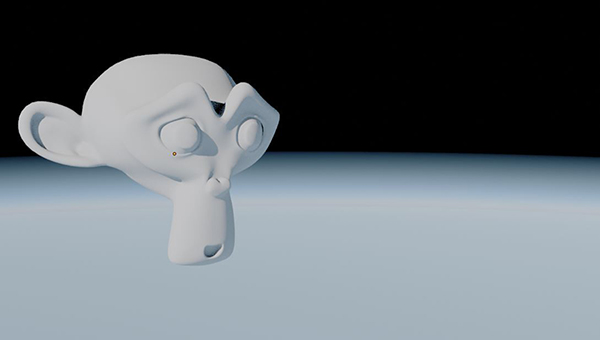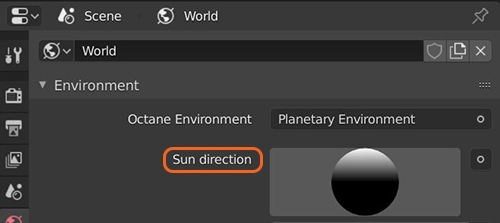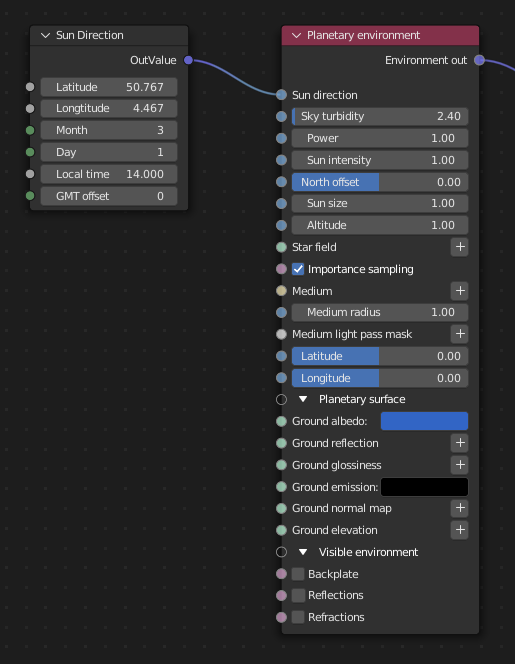
Planetary environments are flexible Nishita sky models. It is most useful when rendering scenes as they are seen from outer space. For its effects to be visible, the camera has to have a very high altitude as it moves out into outer space to view the expansive horizon of the planetary body (Figure 1).

Figure 1: An object rendered at a Camera altitude of 100,000
It takes into account the conditions within and beyond the atmosphere of a planetary body and its surroundings in space. Instead of a single ground color and a sky/sunset color, there is a planetary surface that reflects and emits light. Most importantly, this node serves to extend the Environment's Medium (volume rendering and subsurface scattering) with an atmospheric scattering through the planetary body's atmosphere. Here, the atmosphere is perceived as a layer of gas surrounding a planetary mass, and it is held in place because of gravity so as the light travels into atmosphere either from the outer layer to the ground or from a light source within the atmosphere, then the atmosphere's density is sampled along the ray at regular intervals resulting in an amount of scattering based on the atmosphere's density. This atmospheric scattering is based on the Nishita sky model, a physically-based model that displays the color variations that are optical effects caused by the particles in the atmosphere.
This Environment is not connected to the Camera, and you can zoom the Camera's view of the objects in the scene in and out while not affecting the environment's position in the scene. It is a physically-based model so it gathers optical depth (transmittance) from the sun position, if the sun's Y Axis position is greater than 0.0, then it gets colored. If the Y Axis position is less than 0.0, then it won't gather transmittance and becomes invisible.
Sun Direction - The Sun’s X, Y, and Z direction, which is enabled for the Sun Direction daylight type. You can edit this by clicking and dragging on the Sphere icon (Figure 2). If you connect a Sun Direction node to a Daylight environment, the Sphere icon isn't available and the sun direction is controlled by Latitude, Longitude, Month, Day, Local Time, and GMT Offset (figure 3).

Figure 2: The Sun Direction Sphere icon

Figure 3: Using a Sun Direction node to control the sun's placement
Sky Turbidity - Adjusts the sharpness of the sun light's shadows. Low values create sharp shadows (like on a sunny day) and high values diffuse the shadows (like on a cloudy day).
Power - Adjusts the light's strength. This affects the image's overall contrast and exposure level.
Sun Intensity - Scale factor that is applied to the Sun only. Values other than 1 can produce unrealistic value.
North Offset - Adjusts the scene's actual North direction. This is useful for architecture visualization to ensure the sun's direction is accurate to the scene.
Sun Size - Controls the sun's radius in the Daylight environment
Altitude - The camera's altitude. Set this to a very high value in order to view the planet's expansive horizon.
Star Field - A Texture that conveys star fields behind the planet.
Importance Sampling - This toggles the Sky texture's importance sampling, which is like the Texture environment's importance sampling.
Medium - Accepts an AbsorptionDefines how fast light is absorbed while passing through a medium., ScatteringDefines how fast light gets scattered when traveling through the medium., or Volume medium to create volume/fog effects across the scene.
Medium Radius - The Environment medium's radius, which acts as a sphere around the camera's position with the specified radius.
Latitude - The latitude coordinate of the camera's current position.
Longitude - The longitude coordinate of the camera's current position.
Ground Albedo - The planet's surface Texture map.
Ground Reflection - The planet's specular Texture map.
Ground Glossiness - The planetary glossiness.
Ground Emission - The planet's surface Texture map at nighttime.
Ground Normal Map - The planet's Normal map.
Ground Elevation - The planet's Elevation map.
Environment nodes have extra options to control the environment's behavior when it's the visible Environment. When you use the Node as a Normal environment, these options are ignored: